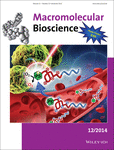Journal list menu
Export Citations
Download PDFs
Cover Picture
Cover Picture: Macromol. Biosci. 12/2014
- Page: 1663
- First Published: 09 December 2014
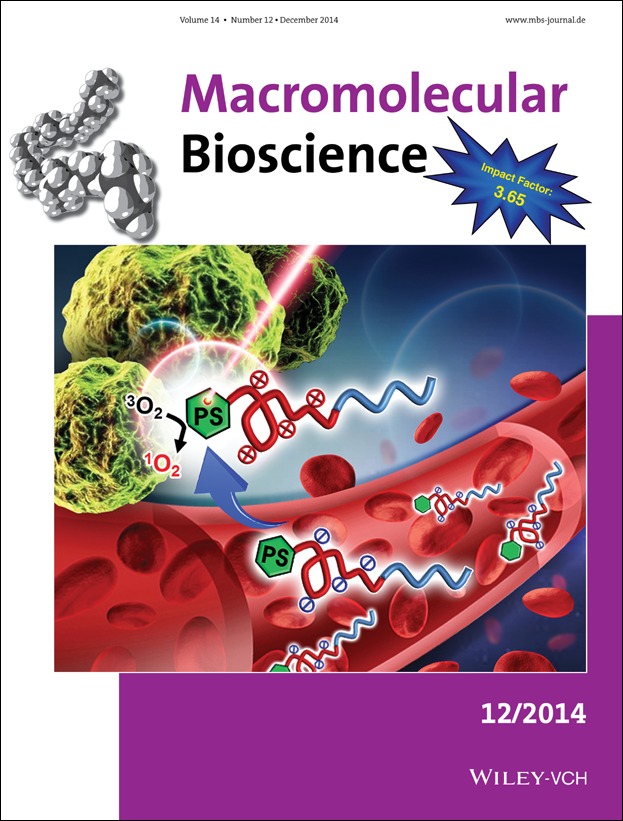
Front Cover: On page 1688 K. Na and co-workers present a cancer-recognizing polymeric photosensitizer (CRPP) that not only has high water solubility but is also pH-responsive to targeted cancer PDT. The newly synthesized CRPP is capable of reversing its charge from negative to positive at the tumor extracellular pH (pHe, pH≈6.5) to facilitate cellular internalization, which can lead to enhanced therapeutic efficacy against tumor cells.
Back Cover
Back Cover: Macromol. Biosci. 12/2014
- Page: 1816
- First Published: 09 December 2014
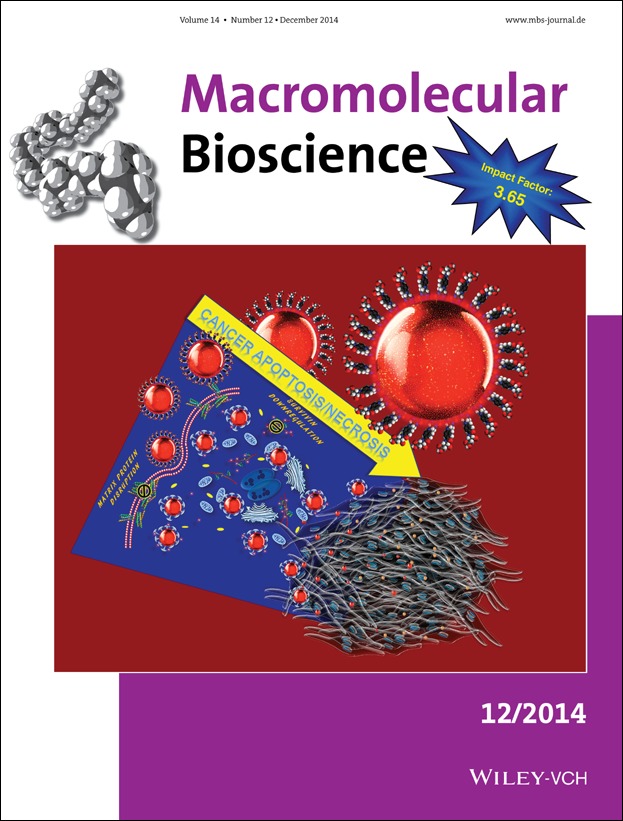
Back Cover: A multifunctional folate targeted ribotoxinpolymeric/lipid nanoformulation is used to image and specifically arrest the proliferation tendencies of human glioblastoma by additionally suppressing the anti-apoptotic survivin and membrane interaction vinculin proteins. The formulation presented by D. S. Kumar and co-workers on page 1696 could be used as a potent theranostic vector system for diverse cancer subtypes.
Masthead
Contents
Contents: Macromol. Biosci. 12/2014
- Pages: 1665-1669
- First Published: 09 December 2014
Communication
Collagen Surfaces Modified with Photo-Cleavable Polyethylene Glycol-Lipid Support Versatile Single-Cell Arrays of Both Non-adherent and Adherent Cells
- Pages: 1670-1676
- First Published: 05 September 2014

A smart-material surface for simply and rapidly preparing versatile single-cell arrays of both non-adherent and adherent cells was designed and constructed based on a photo-cleavable polyethylene glycol (PEG)-lipid. Two high-throughput image analysis applications were demonstrated on these PEG-lipid-based single cell arrays. In addition, extremely densely-packed single-cell arrays were successfully constructed.
Full Papers
Liposomal Drug Deposits in Poly(Dopamine) Coatings: Effect of Their Composition, Cell Type, Uptake Pathway Considerations, and Shear Stress
- Pages: 1677-1687
- First Published: 11 September 2014

Different types of liposome-containing poly(dopamine)-based films were assembled and their interaction with adhering cells was assessed. The internalization of cargo was not affected by the presence of lipophilic dopamine conjugates in the lipid membrane but by the charge of the liposomes. Clathrin-mediated endocytosis was identified as uptake pathway. Shear stress had an impact on the interaction of adhering endothelial cells with the composite films.
A Cancer-Recognizing Polymeric Photosensitizer Based on the Tumor Extracellular pH Response of Conjugated Polymers for Targeted Cancer Photodynamic Therapy
- Pages: 1688-1695
- First Published: 24 September 2014

A cancer-recognizing polymeric photosensitizer (CRPP) for targeted photodynamic cancer therapy is developed through a facile synthetic process. The newly synthesized CRPP is capable of reversing its charge from negative to positive at the tumor extracellular pH (pHe, pH ∼6.5) to facilitate cellular internalization, which can lead to enhanced therapeutic efficacy against tumor cells.
Structurally Distinct Hybrid Polymer/Lipid Nanoconstructs Harboring a Type-I Ribotoxin as Cellular Imaging and Glioblastoma-Directed Therapeutic Vectors
- Pages: 1696-1711
- First Published: 02 September 2014
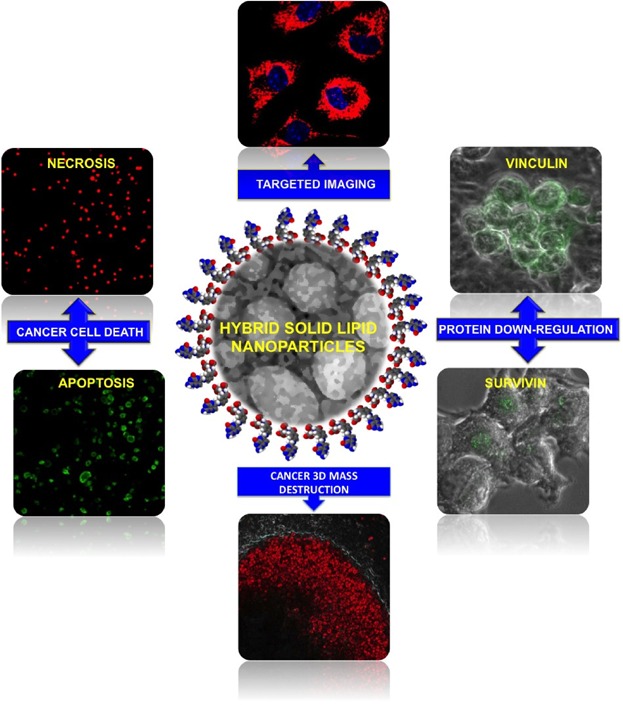
A multicomponent polymeric/lipid nano-construct encompassing a plant toxin and imaging dye was utilized to specifically curb the proliferation tendencies of glioblastoma in addition to suppressing the anti-apoptotic survivin and membrane interaction vinculin proteins. The cytocompatibility and multifunctionality of the nanoparticles significantly projects their prospective theranostic potential.
Preparation and Bioimaging Applications of AIE Dye Cross-linked Luminescent Polymeric Nanoparticles
- Pages: 1712-1718
- First Published: 08 September 2014
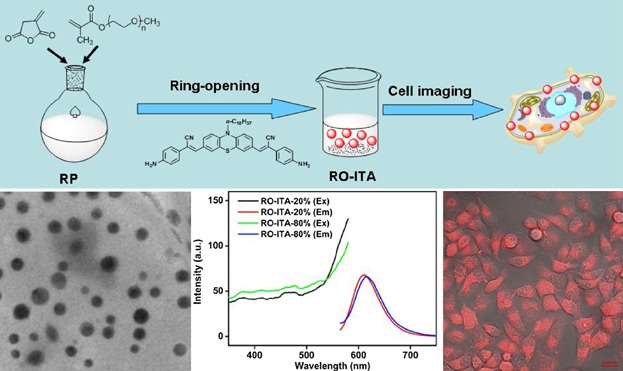
We demonstrate that red luminescent polymeric nanoparticles can be prepared via combination of free radical polymerization and a ring-opening reaction using aggregation-induced emission dye as cross-linker. The good water dispersibility, size, enhanced fluorescence intensity, and excellent biocompatibility that these luminescent polymeric nanoparticles exhibit gives them good potential for biological imaging applications.
A Combined Micelle and Poly(Serinol Hexamethylene Urea)-Co-Poly(N-Isopropylacrylamide) Reverse Thermal Gel as an Injectable Ocular Drug Delivery System
- Pages: 1719-1729
- First Published: 03 September 2014
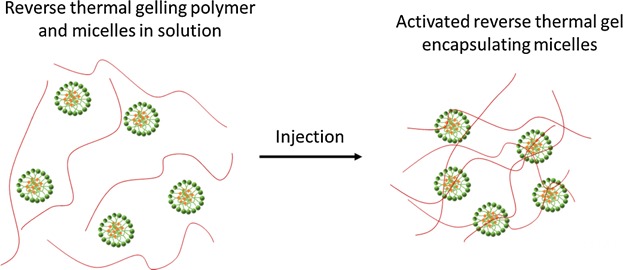
A poorly-soluble ocular corticosteroid is encapsulated within polymeric micelles, which are mixed with a novel reverse thermal gel to form an injectable long-term drug delivery system. This combined system improves release kinetics of the drug over micelles or reverse thermal gel alone by eliminating burst release behavior and extending the timeframe of drug release.
Microfluidic Synthesis of Pharmacologically Responsive Supramolecular Biohybrid Microgels
- Pages: 1730-1734
- First Published: 03 September 2014
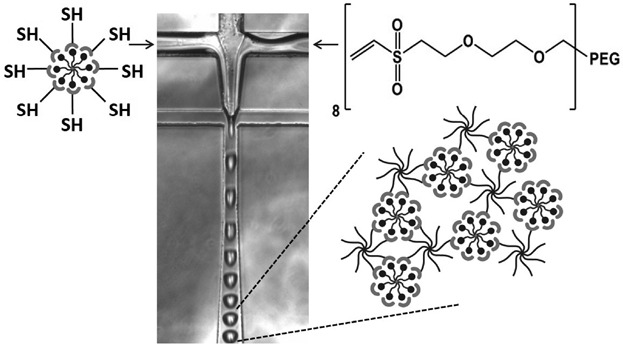
We describe the microfluidic synthesis of pharmacologically responsive biohybrid hydrogel particles synthesized from 8-arm poly(ethylene glycol) coupled to fluorescein and a fluorescein-specific humanized antibody fragment. Mixing the reactants in a microfluidic device results in narrowly dispersed microgels that can be degraded selectively by addition of fluorescein to disrupt the antigen–antibody ties.
In Vitro Synergistic Action of Geldanamycin- and Docetaxel-Containing HPMA Copolymer–RGDfK Conjugates Against Ovarian Cancer
- Pages: 1735-1747
- First Published: 04 September 2014
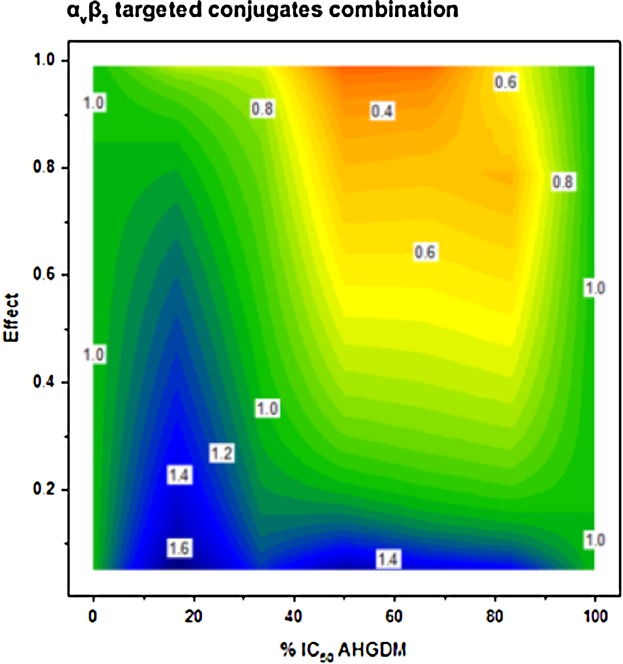
In vitro evaluation of combination therapy utilizing HPMA copolymer–RGDfK conjugates. Aminohexylgeldanamycin conjugates are more stable and exhibit slower drug release than docetaxel conjugates. Both conjugates demonstrate binding specifically to αvβ3 integrins. HPMA copolymer–RGDfK conjugates bearing aminohexylgeldanamycin and docetaxel induce cytotoxicity synergistically suggesting potential as combination therapy for ovarian cancer.
Decomposition and Transformation of Pyrene-Derivative Micelles at Intracellular Milieu and Their Influence on Cytoviability
- Pages: 1748-1754
- First Published: 10 September 2014
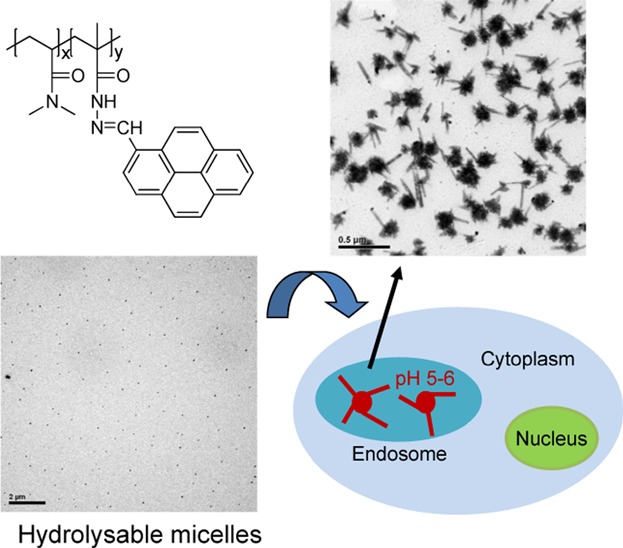
Amphiphilic pyrene-containing random copolymers with pH-sensitive hydrazone bonds are synthesized. Spherical hydrolysable micelles formed by the amphiphilic copolymers at pH 6 are transformed into nanorods due to cleavage of the hydrazone bonds. The shape transformation is observed in pH 5.5 PBS too. The hydrolysable micelles cause higher toxicity to A549 cells than the non-hydrolysable ones without shape transformation.
Cell Motility on Polyethylene Glycol Block Copolymers Correlates to Fibronectin Surface Adsorption
- Pages: 1755-1763
- First Published: 10 September 2014

Cell morphology and motility on artificial surfaces can be controlled by different degrees of surface PEGylations. Here, fibronectin incubation in three different PEG block copolymers is analyzed via neutron reflectivity. Fibronectin adsorbs in the vicinity of the PLL layer. The amount of fibronectin in the polymer layer is correlated to cell spreading and motility.
Bamboo Leaf-Like Micro-Nano Sheets Self-Assembled by Block Copolymers as Wafers for Cells
- Pages: 1764-1770
- First Published: 10 September 2014

Bamboo leaf-like micro-nano sheets are prepared via crystallization-driven self-assembly of poly(ethylene oxide)-b-poly(ϵ-caprolactone). The preparation is quite convenient within 1 h. These polymer sheets look like wafers for cells, and they do display a selective internalization to different cells. The macrophages show great interest in the wafers.
Sprayed Cells and Polyelectrolyte Films for Biomaterial Functionalization: The Influence of Physical PLL–PGA Film Treatments on Dental Pulp Cell Behavior
- Pages: 1771-1782
- First Published: 11 September 2014
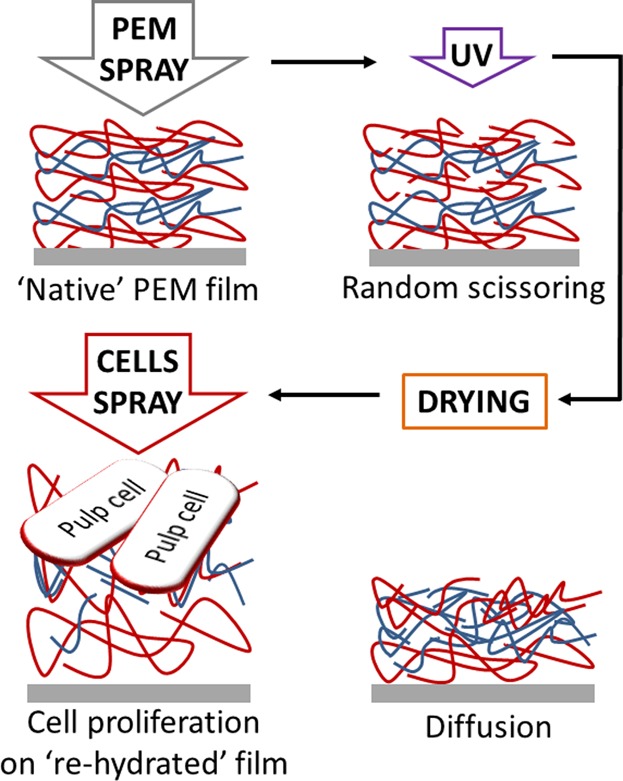
A good manufacturing practice (GMP)-compliant spraying method is described for the buildup of polyelectro-lyte multilayer (PEM) films constructed by poly-L-lysine (PLL) and poly-glutamic acid (PGA), onto which dental pulp cells are also deposited by spraying. The prepared PEM films were exposed to UV irradiation and drying/re-hydrating cycle. This procedure renders the films thicker, rougher and stiffer, enhancing dental pulp cell adhesion and proliferation.
Sulfated Hyaluronan Influences the Formation of Artificial Extracellular Matrices and the Adhesion of Osteogenic Cells
- Pages: 1783-1794
- First Published: 12 September 2014
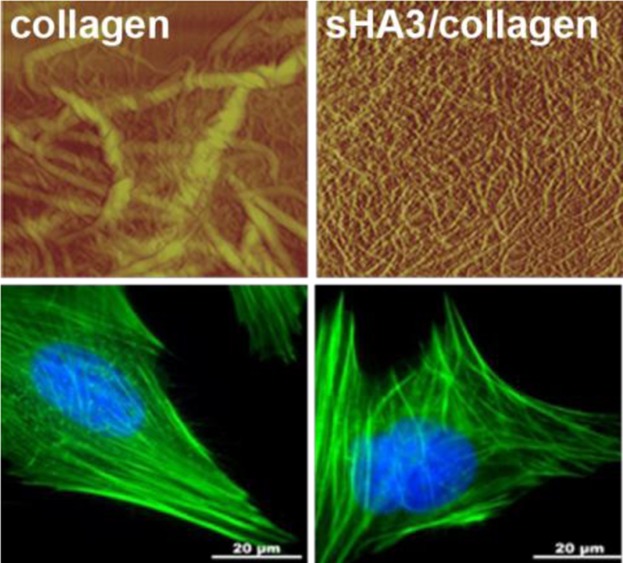
The presence of sulfated glycosaminoglycans (GAG), like sulfated hyaluronan derivatives and chondroitin sulfate, during in vitro-fibrillogenesis of collagen type I alters the structure of the resulting artificial extracellular matrices. Besides, the GAG amount associated to collagen increases in a sulfation-dependent manner. Moreover, GAG sulfation influences the cytoskeletal arrangement of SaOS-2 cells which implies that adhesion-related intracellular signaling is affected.
pH-Responsive Single Walled Carbon Nanotube Dispersion for Target Specific Release of Doxorubicin to Cancer Cells
- Pages: 1795-1806
- First Published: 11 September 2014

pH Responsive cholesterol based dipeptide carboxylates were synthesized as efficient dispersing agents for SWNTs in water. These highly dispersed nanotubes were used for the uploading of anticancer drug doxorubicin. The nanohybrid showed excellent pH responsive drug release at the extracellular tumorogenic environmental pH (6.0–6.5) and selectively kills cancer cells.
Revisiting Complexation between DNA and Polyethylenimine: Does the Disulfide Linkage Play a Critical Role in Promoting Gene Delivery?
- Pages: 1807-1815
- First Published: 29 September 2014
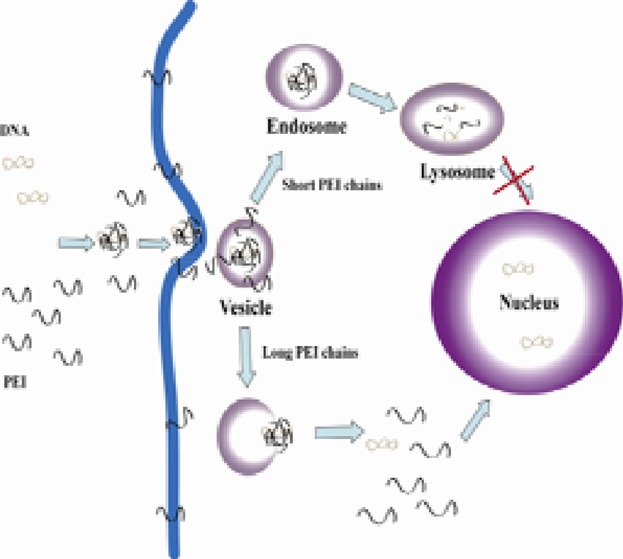
To improve transfection efficiency and lower cytotoxicity, disulfide bonds have been applied in gene vectors. However, the disulfide bonds may not play an important role in promoting gene delivery, but do extend the chain length. A long free PEI chain could efficiently protect DNA from degradation, so that more DNA is transported into the nucleus.




